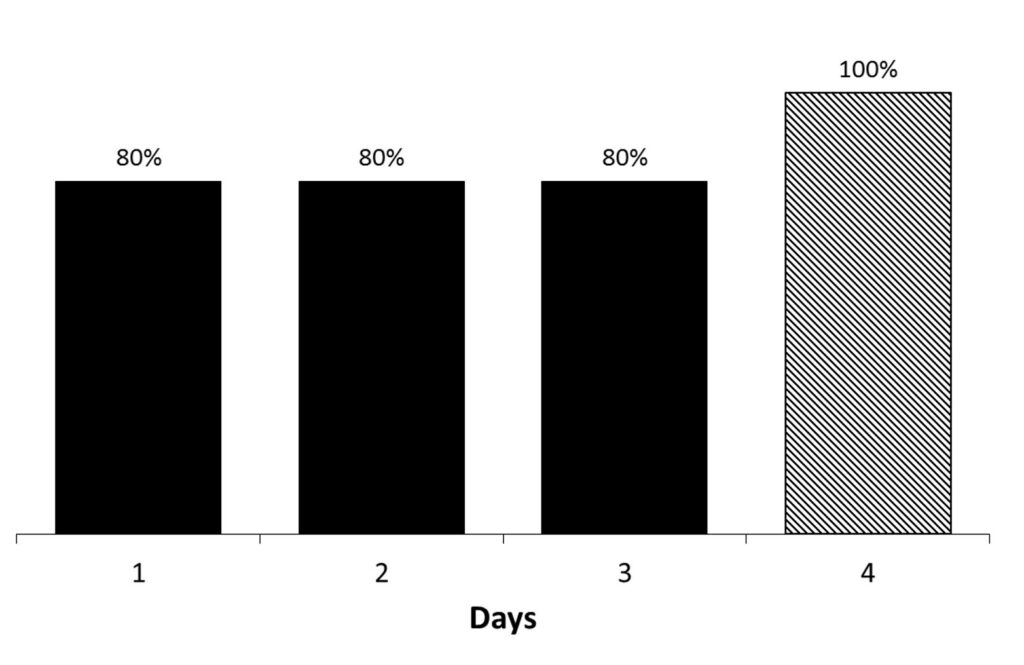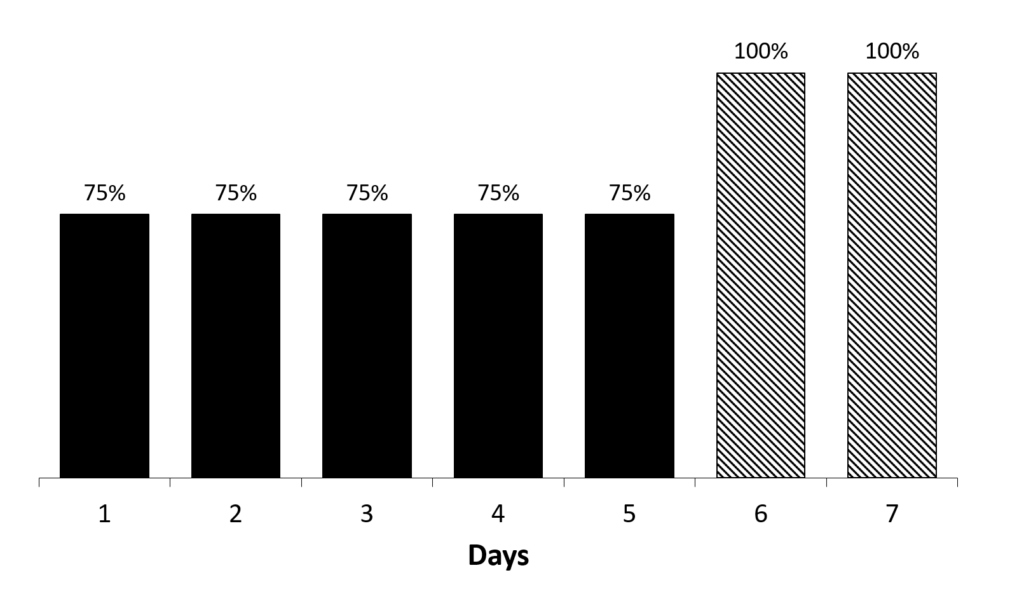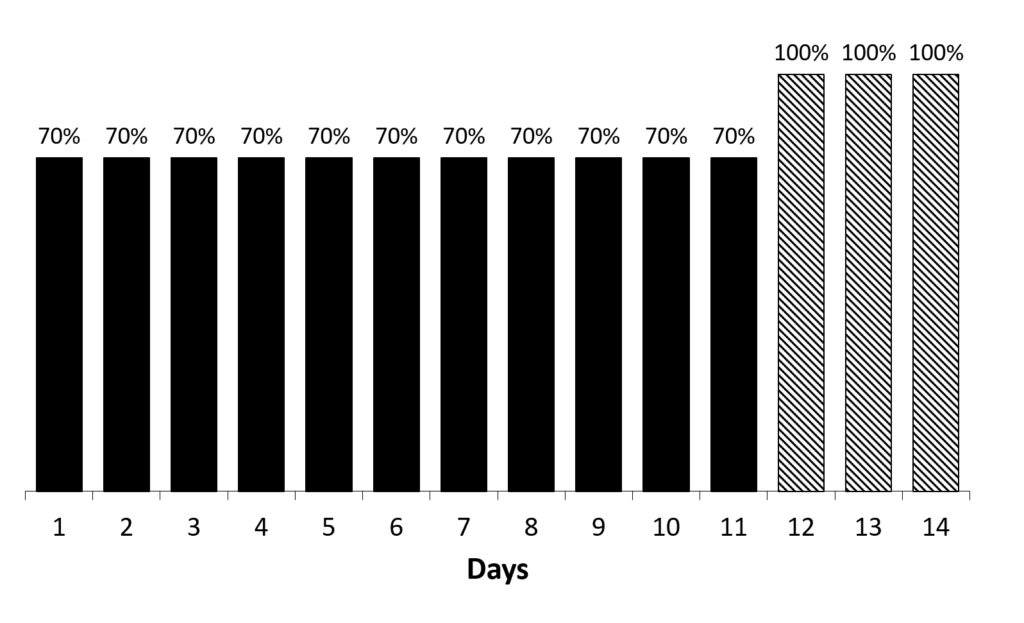Over the years I’ve experimented with numerous nutrition periodization models with both myself and clients.
While it’s not the case with everyone, a large percentage of people tend to respond more favorably to intermittent rather than continuous caloric restriction.
Even in the literature, intermittent dietary strategies have shown promise in those studies where calories were increased to a sufficient degree. In most of the studies that did not show a benefit, caloric intake was not restored to at least maintenance level or above.
It’s worth noting that the main benefit of implementing these strategies is not faster weight loss, but rather, greater lean mass retention, and increased adherence to your meal plan.
So, without further ado, here are three of my favorite nutrition periodization models that I’ve used time and time again with a lot of success.
The 3:1 Zig Zag Cycle
The 3:1 Zig Zag cycle is an effective strategy that can be used for fat loss or muscle building. During a fat loss cycle you would typically alternate 3-days low, eating at around 70-80% of maintenance, with 1 day high, eating at maintenance or slightly above. An example of this model is shown below.

This model works well for leaner clients who tend to crash after being in deficit for a few days. I particularly like this model for males under 8% body fat and females under 15%, which is around the threshold level where hormones and energy levels come crashing.
The Zig Zag cycle can also be used during a muscle building phase. In this instance you would typically alternate 3-days high, eating slightly above maintenance, with one day low, eating at 70-80% of maintenance.
This helps mitigate fat gain during a muscle building phase and allows you to maintain better insulin sensitivity. I’ve found that using this approach the average person can extend a clean bulking phase from 4 weeks to 6-8 weeks or more before requiring a mini-cut.
The 5:2 Cycle
The 5:2 cycle is similar to the zig-zag cycle but instead of doing 3-days low and 1-day high, you do 5 days low, and 2 days high. An example is shown below.

This offers two possible advantages over the 3:1 zig zag cycle. Firstly, having back-to-back high days may be more effective at mitigating or restoring declining hormone levels in response to caloric restriction.
For example, one study found that acute 24hr overfeeding was not sufficient to restore thyroid hormone and luteinizing hormone, in a group of energy restricted women [1]. However, another study found that 48hrs hours of refeeding was able to restore luteinizing hormone levels following 3 days of fasting.
A recent study by Campbell et al compared the effects of continuous caloric restriction for 7 weeks with the 5:2 cycle in a group of trained men and women [3]. The continuous group was placed in a 25% deficit per day while the refeed group did 5 days at 35% deficit and 2 days at maintenance. The average weekly deficit for both groups was 25%.
On average, the refeed group retained more lean muscle mass and lost slightly more body fat. They also had a slightly lower reduction in resting metabolic rate, although it wasn’t clinically significant.
What was interesting about this study is that about half of the participants in the refeed group responded very positively to the intervention. They actually gained lean mass while being in a weekly deficit. The remaining participants though responded similar to the participants in the continuous group.
So, it appears that not everyone benefits equally from refeeding. Some people tend to be hyper-responders while others are non-responders.
My personal theory on this is that individuals with higher baseline catecholamine activity i.e. those that tend to secret more stress hormones, stand to benefit most from overfeeding since being in a chronically stressed state can send them into a catabolic state.
The second benefit of the 5:2 model is that it is that fits in well with most people’s weekly schedule. Many people prefer to eat a bit less on weekdays so they can enjoy a bit more food and flexibility on the weekends.
However, be mindful that in some people, refeeding can send them into a binge eating frenzy. So once again, this model is not for everyone.
The 11:3 Davoodi’s Cycle
Another model that I really like that I’ve used many times is the 11:3 Davoodi cycle. This model alternates 11 days low, eating at around 70-80% of maintenance, with 3 days high, eating at maintenance or slightly above. Below is an example of what that looks like.

This model was named after author Sayeed Davoodi who published a study in 2014 reporting that the 11:3 model out-performed continuous caloric restriction over a 6-week period, even though the participant in the 11:3 group were not a deficit for 9-days during the intervention period [4].
Not only that, but by the end of the study the participants in the 11:3 group experienced almost no reduction in resting metabolic rate compared with the continuous group.
I particularly like this model for moderately lean clients who still stand to benefit from refeeding but may not require such frequent refeeds as the 3:1 or 5:2 approach.
That’s because as a rule of thumb, the leaner someone is, the quicker their hormone levels and metabolism tank, and the quicker they tend to crash.
This model is also user friendly like the 5:2 models because dieters get to eat relatively normally every second weekend from Friday to Sunday. The sustainability of a diet is highly important because it improves long term dietary compliance.
So, there you have it. Three tried and tested nutrition periodization models that you can experiment with to assist with your dieting efforts. Although these methods are not magic, they can certainly make your diet more enjoyable and easier to stick to, and they can definitely help with maintaining performance in the gym.
References
- Loucks AB, Verdun M. Slow restoration of LH pulsatility by refeeding in energetically disrupted women. Am J Physiol. 1998 Oct;275(4):R1218-26. doi: 10.1152/ajpregu.1998.275.4.R1218. PMID: 9756553.
- Olson BR, Cartledge T, Sebring N, Defensor R, Nieman L. Short-term fasting affects luteinizing hormone secretory dynamics but not reproductive function in normal-weight sedentary women. J Clin Endocrinol Metab. 1995 Apr;80(4):1187-93. doi: 10.1210/jcem.80.4.7714088. PMID: 7714088.
- Campbell BI, et al. Intermittent Energy Restriction Attenuates the Loss of Fat Free Mass in Resistance Trained Individuals. A Randomized Controlled Trial. J. Funct. Morphol. Kinesiol. 2020, 5, 19
- Davoodi SH, et al. Calorie Shifting Diet Versus Calorie Restriction Diet: A Comparative Clinical Trial Study. International Journal of Preventive Medicine, 2014; 5(4), 447.







